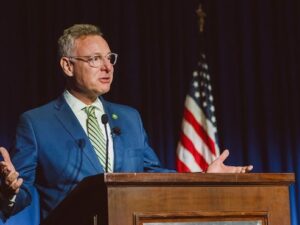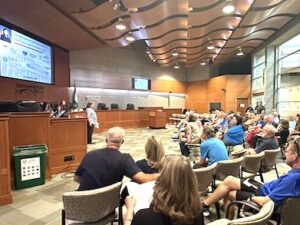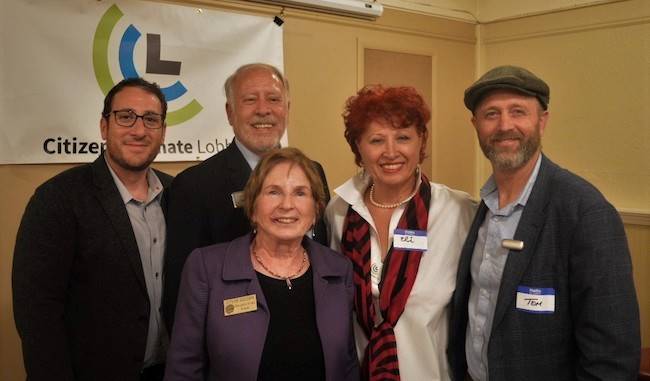
(L-R) Jonathan Wachtel, Sustainability Manage-Lakewood; Mayor Bud Starker, Wheat Ridge; Mayor Marjorie Sloan, Golden; Eli Isely, CCL member & event sponsor; Tom Plant, panel moderator from the Center for New Energy Economy
Colorado CCL chapter convenes local mayors to discuss climate solutions
By Mary Gable
Why do cities matter when it comes to climate action? First, cities are where the people are. Today, more than 8 in 10 Americans live in a city, and over half of the world’s population does. Cities are also where the money is. If the U.S.’s 19 largest cities were individual nations, they’d rank among the world’s 50 largest economies.
Given their greater density and economic activity than suburban or rural areas, cities are also where most of the emissions are. The UN estimates that the world’s cities are responsible for 70 percent of energy-related GHG emissions and use most of the global energy supply. They are also uniquely vulnerable to climate change. Eight of the world’s top 10 largest cities are located on coastlines, making issues like sea level rise a serious concern.
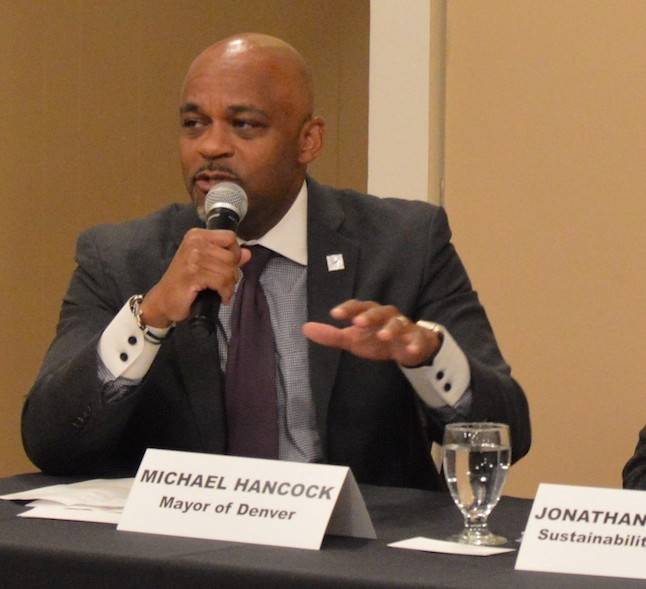
Denver’s Mayor Michael Hancock participated in the climate-focused panel discussion with other area mayors.
But cities are also uniquely suited to enact climate solutions. In cities, the overwhelming size and complexity of the climate crisis achieves a more manageable scale. Citizens can talk with each other and their local leaders about issues that affect their lives in concrete and recognizable ways. Policymakers can act quickly, prioritizing the issues that their constituents value most. In the process, they can conduct policy experiments that can later be applied elsewhere.
Over the past several years, this is exactly what has happened. More than 400 U.S. mayors have announced their continued support of the Paris Agreement. An impressive number of climate and clean energy bills were signed in 2019 in cities and states nationwide. Twenty-two states, 550 cities, and 900 companies have made climate commitments. And if they stick to the goals that they’ve reported, America’s Paris target could still be within reach.
Climate action in the Centennial State
The state of Colorado offers examples of more localized climate progress. Many parts of the state, such as San Miguel and Ouray Counties, are already seeing substantial warming, up to 4.4 degrees Fahrenheit. Droughts, flooding, and wildfires have caused significant damage. And policymakers have responded, with the 2019 Colorado Legislature passing a suite of bills related to greenhouse gas emissions, clean air, and transportation.
To highlight the range of actions that cities are taking to address the climate crisis, the Golden, Colorado chapter of Citizens’ Climate Lobby hosted a panel discussion for mayors of Colorado cities. Hosted at the Denver Press Club on September 24, the panel featured Mayor Michael Hancock, Denver; Mayor Marjorie Sloan, Golden; Mayor Bud Starker, Wheat Ridge; and Jonathan Wachtel, Sustainability Manager for the City of Lakewood. Tom Plant, Senior Policy Advisor at the Colorado State University Center for the New Energy Economy, moderated the discussion. Golden CCL member Eli Isely organized the event, supported by a planning committee including Phil Nelson, Rob Robinson, Wendi Sisk, Becky Snell Labson, Kathleen Wells, Kaaren Hardy, Luke Wheeler and Susan Ludwig.
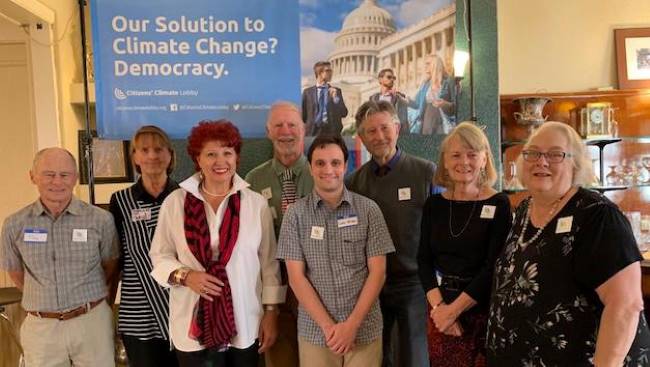
These CCL volunteers planned, promoted, and executed this wonderful event.
The panelists discussed some of the major contributors to emissions in cities, including electricity generation, transportation, and buildings. They shared their cities’ plans to advance electric vehicle adoption and the availability of charging infrastructure. And they explained strategies for mitigating and adapting to the climate impacts they’re already seeing.
Looking beyond city limits
Through these conversations, a few themes emerged. One was the role of citizens in shaping cities’ climate responses. “Our journey into sustainability really originated with the community stepping up and pushing the city over and over again to talk about issues related to the environment and to climate,” Wachtel said. Mayor Hancock spoke about equity and the importance of including low-income communities and communities of color in the conversation.
The mayors also stressed the need for collaboration, both within and across cities and beyond. Several mentioned the Metro Mayors Caucus, which convenes Denver-area mayors throughout the year to share common challenges and solutions. “Jurisdictional boundaries are meaningless when it comes to wildfire smoke, when it comes to transportation issues, floods, people who need help in housing, and other issues that are very closely connected with sustainability,” explained Mayor Sloan. Mayor Starker emphasized the need to collaborate in areas of transportation and flood control. You can watch the whole panel here:
This is the thorny reality of the climate crisis. City- and state-level action is necessary, but it’s not sufficient. The outcomes of our actions, whether good or bad, will be felt near and far. This helps explain why, in July, the U.S. Conference of Mayors called for Congress to set a federal price on carbon. Cities can do a lot—but they can’t do it alone.
A national commitment to climate action won’t be easy. But the more conversations we have and success stories we share, the more likely we are to find common ground. We’re encouraged by the example set by Colorado mayors who are not only making progress within their own jurisdictions, but also thinking big and helping others do the same.



